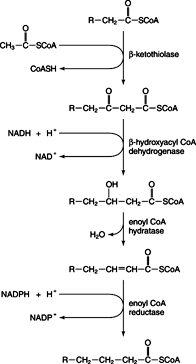The elongated 4‐carbon chain is now ready to accept a new 2‐carbon unit from malonyl‐CoA. The 2‐carbon unit, which is added to the growing fatty acid chain, becomes carbons 1 and 2 of hexanoic acid (6‐carbons).
Release
The cycle of transfer, elongation, reduction, dehydration, and reduction continues until palmitoyl‐ACP is made. Then the thioesterase activity of the FAS complex releases the 16‐carbon fatty acid palmitate from the FAS.
Note that fatty acid synthesis provides an extreme example of the phenomenon of metabolic channeling: neither free fatty acids with more than four carbons nor their CoA derivatives can directly participate in the synthesis of palmitate. Instead they must be broken down to acetyl‐CoA and reincorporated into the fatty acid.
Fatty acids are generated cytoplasmically while acetyl‐CoA is made in the mitochondrion by pyruvate dehydrogenase.This implies that a shuttle system must exist to get the acetyl‐CoA or its equivalent out of the mitochondrion. The shuttle system operates in the following way: Acetyl‐CoA is first converted to citrate by citrate synthase in the TCA‐cycle reaction. Then citrate is transferred out of the mitochondrion by either of two carriers, driven by the electroosmotic gradient: either a citrate/phosphate antiport or a citrate/malate antiport as shown in Figure 2 .

Figure 2
After it is in the cytosol, citrate is cleaved to its 2‐ and 4‐carbon components by citrate lyase to make acetyl‐CoA and oxaloacetate. Citrate lyase requires ATP.
Fatty acid biosynthesis (and most biosynthetic reactions) requires NADPH to supply the reducing equivalents. Oxaloacetate is used to generate NADPH for biosynthesis in a two‐step sequence. The first step is the malate dehydrogenase reaction found in the TCA cycle. This reaction results in the formation of NAD from NADH (the NADH primarily comes from glycolysis). The malate formed is a substrate for the malic enzyme reaction, which makes pyruvate, CO 2, and NADPH. Pyruvate is transported into the mitochondria where pyruvate carboxylase uses ATP energy to regenerate oxaloacetate.
Palmitate is the starting point for other fatty acids that use a set of related reactions to generate the modified chains and head groups of the lipid classes. Microsomal enzymes primarily catalyze these chain modifications. Desaturation uses O 2 as the ultimate electron acceptor to introduce double bonds at the nine, six, and five positions of an acyl‐CoA.
Elongation is similar to synthesis of palmitate because it uses malonyl‐CoA as an intermediate. See Figure 3.

Figure 3